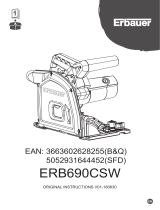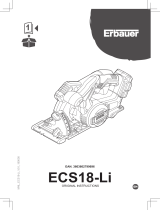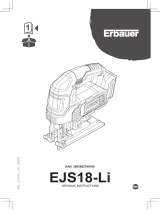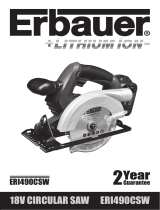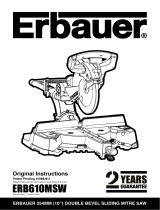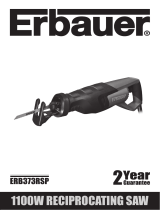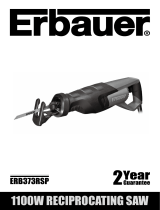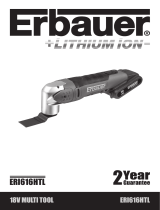Page is loading ...

2000W 235mm CIRCULAR SAW ERB596CSW
ERB596CSW

Original Instructions
(Version 1.0)

2000W 235mm CIRCULAR SAW ERB596CSW
GUARANTEE
This product carries a 2 years guarantee. If your product develops a fault
within this period, you should in the rst instance contact the retailer where the item was
purchased.
This guarantee specically excludes losses caused due to:
- Fair wear and tear
- Misuse or abuse
- Lack of routine maintenance
- Failure of consumable items (such as batteries)
- Accidental damage
- Cosmetic damage
- Failure to follow manufacturer’s guidelines
- Loss of use of the goods
This guarantee does not affect your statutory rights. This guarantee is only valid in the UK.
For further technical advice, spare parts or repair service (outside of guarantee) please
contact the customer helpline number on 0345 607 6380.
Congratulations on your purchase of a quality power tool from Erbauer (UK) Ltd. This
product should give you reliable service but for your peace of mind this
power tool does carry a 2 year guarantee, the terms of which are detailed below.
If this product develops a fault within the guarantee period contact your retailer.
Please retain this handbook in case you need to refer to safety, care or guarantee
information in the future.

GENERAL POWER TOOL SAFETY WARNINGS
Warning: Read all safety warnings and all instructions.
Failure to follow the warnings and instructions may result in
electric shock, re and/or serious injury.
Save all warnings and instructions for future reference.
The term “power tool” in the warnings refers to your electric (corded)
power tool or battery-operated (cordless) power tool.
1. Work area safety
a. Keep work area clean and well lit. Cluttered or dark areas
invite accidents.
b. Do not operate power tools in explosive atmospheres,
such as in the presence of ammable liquids, gases or dust.
Power tools create sparks which may ignite the dust or fumes.
c. Keep children and bystanders away while operating a
power tool. Distractions can cause you to lose control.
2. Electrical safety
a. Power tool plugs must match the outlet. Never modify the
plug in any way. Do not use any adapter plugs with earthed
(grounded) power tools. Unmodied plugs and matching outlets
will reduce risk of electric shock.
b. Avoid body contact with earthed or grounded surfaces,
such as pipes, radiators, ranges and refrigerators. There
is an increased risk of electric shock if your body is earthed or
grounded.
c. Do not expose power tools to rain or wet conditions. Water
entering a power tool will increase the risk of electric shock.
d. Do not abuse the cord. Never use the cord for carrying,
pulling or unplugging the power tool. Keep cord away from
heat, oil, sharp edges or moving parts. Damaged or entangled
cords increase the risk of electric shock.
e. When operating a power tool outdoors, use an extension
cord suitable for outdoor use. Use of a cord suitable for outdoor
use reduces the risk of electric shock.
f. If operating a power tool in a damp location is unavoidable,
use a residual current device (RCD) protected supply. Use of
an RCD reduces the risk of electric shock.

2000W 235mm CIRCULAR SAW ERB596CSW
3. Personal safety
a. Stay alert, watch what you are doing and use common
sense when operating a power tool. Do not use a power tool
while you are tired or under the inuence of drugs, alcohol
or medication. A moment of inattention while operating power
tools may result in serious personal injury.
b. Use personal protective equipment. Always wear eye
protection. Protective equipment such as dust mask, non-skid
safety shoes, hard hat, or hearing protection used for appropriate
conditions will reduce personal injuries.
c. Prevent unintentional starting. Ensure the switch is in
the off-position before connecting to power source and/or
battery pack, picking up or carrying the tool. Carrying power
tools with your nger on the switch or energising power tools that
have the switch on invites accidents.
d. Remove any adjusting key or wrench before turning the
power tool on.
A wrench or a key left attached to a rotating part of the power tool
may result in personal injury.
e. Do not overreach. Keep proper footing and balance
at all times. This enables better control of the power tool in
unexpected situations.
f. Dress properly. Do not wear loose clothing or jewellery.
Keep your hair, clothing and gloves away from moving parts.
Loose clothes, jewellery or long hair can be caught in moving
parts.
g. If devices are provided for the connection of dust
extraction and collection facilities, ensure these are
connected and properly used. Use of dust collection can
reduce dust-related hazards.
4. Power tool use and care
a. Do not force the power tool. Use the correct power tool for
your application. The correct power tool will do the job better
and safer at the rate for which it was designed.
b. Do not use the power tool if the switch does not turn it on
and off. Any power tool that cannot be controlled with the switch
is dangerous and must be repaired.

c. Disconnect the plug from the power source and/or
the battery pack from the power tool before making any
adjustments, changing accessories, or storing power tools.
Such preventive safety measures reduce the risk of starting the
power tool accidentally.
d. Store idle power tools out of the reach of children and
do not allow persons unfamiliar with the power tool or
these instructions to operate the power tool. Power tools are
dangerous in the hands of untrained users.
e. Maintain power tools. Check for misalignment or binding
of moving parts, breakage of parts and any other condition
that may affect the power tool’s operation. If damaged,
have the power tool repaired before use. Many accidents are
caused by poorly maintained power tools.
f. Keep cutting tools sharp and clean. Properly maintained
cutting tools with sharp cutting edges are less likely to bind and
are easier to control.
g. Use the power tool, accessories and tool bits etc. in
accordance with these instructions, taking into account the
working conditions and the work to be performed. Use of
the power tool for operations different from those intended could
result in a hazardous situation.
5. Service
a. Have your power tool serviced by a qualied repair person
using only identical replacement parts. This will ensure that
the safety of the power tool is maintained.
ADDITIONAL SAFETY RULES FOR YOUR CIRCULAR SAW
1. Always wear a dust mask, hearing protection and eye
protection.
2. Only use saw blades recommended in the specication.
3. Do not use any abrasive wheels.
4. Use only blade diameter(s) in accordance with the markings.
5. Always wear gloves when handling saw blades and rough
material. Saw blades shall be carried in a holder whenever
practicable.

2000W 235mm CIRCULAR SAW ERB596CSW
6. When an extension cable is required you must ensure it has
the correct ampere rating for your power tool and is in a safe
electrical condition. And please always fully unwind cable drum
extension to avoid potential overheating.
7. Ensure your mains supply voltage is the same as indicated on
the rating plate.
8. Before cutting, check the cutting line is free of nails, screws,
etc.
9. Only make cuts with the blade direction downwards, never
upwards or at the side.
10. Do not use a blade unless the rated blade speed exceeds the
saw no load speed.
11. Never remove the guard system. Never use the saw if the
guard system does not function correctly. Never lock the
moving guard open. The guard must move freely.
12. Never use saw blades made from high speed steel (HSS).
13. Always check walls, oors and ceilings to avoid hidden power
cable and pipes.
14. Do not cut material containing asbestos.
15. Do not use circular saw to cut tree limbs or logs.
16. Do not use metal or stone saw blades. Only use wood saw
blades.
17. Do not use circular saw to cut tree limbs or logs.
18. Do not use any abrasive wheels.
19. Use only blade diameter(s) in accordance with the markings.
Warning:
a. Keep hands away form cutting area and the blade. Keep
your second hand on auxiliary handle, or motor housing. If
both hands are holding the saw, they cannot be cut by the blade.
b. Do not reach underneath the work-piece. The guard cannot
protect you from the blade below the work-piece.
c. Adjust the cutting depth to the thickness of the work-piece.
Less than a full tooth of the blade teeth should be visible below
the work-piece.
d. Never hold piece being cut in your hands or across
your leg. Secure the work-piece to a stable platform. It

is important to support the work properly to minimize body
exposure, blade binding, or loss of control.
e. Hold power tool by insulated gripping surfaces when
performing an operation where the cutting tool may contact
hidden wiring or its own cord. Contact with a “live” wire will
also make exposed metal parts of the power tool “live” and shock
the operator.
f. When ripping always use a rip fence or straight edge guide.
This improves the accuracy of cut and reduce the chance of
blade binding.
g. Always use blades with correct size and shape (diamond
versus round) of arbor holes. Blades that do not match the
mounting hardware of the saw will run eccentrically, causing loss
of control.
h. Never use damaged or incorrect blade washers or bolt. The
blade washers and bolt were specially designed for your saw, for
optimum performance and safety of operation.
FURTHER SAFETY INSTRUCTIONS FOR CIRCULAR SAWS
KICKBACK CAUSES AND RELATED WARNINGS
- Kickback is a sudden reaction to a pinched, bound or
misaligned saw blade, causing an uncontrolled saw to lift up
and out of the workpiece toward the operator;
- When the blade is pinched or bound tightly by the kerf closing
down, the blade stalls and the motor reaction drives the unit
rapidly back toward the operator;
- If the blade becomes twisted or misaligned in the cut, the teeth
at the back edge of the blade can dig into the top surface of the
wood causing the blade to climb out of the kerf and jump back
toward the operator.
Kickback is the result of saw misuse and/or incorrect operating
procedures or conditions and can be avoided by taking proper
precautions as given below.
a) Maintain a rm grip with both hands on the saw and
position your arms to resist kickback forces. Position
your body to either side of the blade, but not in line with
the blade. Kickback could cause the saw to jump backwards,
but kickback forces can be controlled by the operator, if proper

2000W 235mm CIRCULAR SAW ERB596CSW
precautions are taken.
b) When blade is binding, or when interrupting a cut for any
reason, release the trigger and hold the saw motionless
in the material until the blade comes to a complete stop.
Never attempt to remove the saw from the work or pull the
saw backward while the blade is in motion or kickback may
occur. Investigate and take corrective actions to eliminate the
cause of blade binding.
c) When restarting a saw in the workpiece, centre the saw
blade in the kerf and check that saw teeth are not engaged
into the material. If saw blade is binding, it may walk up or
kickback from the workpiece as the saw is restarted.
d) Support large panels to minimise the risk of blade pinching
and kickback. Large panels tend to sag under their own
weight. Supports must be placed under the panel on both sides,
near the line of cut and near the edge of the panel.
e) Do not use dull or damaged blades. Unsharpened or
improperly set blades produce narrow kerf causing excessive
friction, blade binding and kickback.
f) Blade depth and bevel adjusting locking levers must be
tight and secure before making cut. If blade adjustment shifts
while cutting, it may cause binding and kickback.
g) Use extra caution when making a “plunge cut” into existing
walls or other blind areas. The protruding blade may cut
objects that can cause kickback.
SAFETY INSTRUCTION FOR CIRCULAR SAW WITH INNER
PENDULUM GUARD
a) Check lower guard for proper closing before each use. Do
not operate the saw if lower guard does not move freely
and close instantly. Never clamp or tie the lower guard into
the open position. If saw is accidentally dropped, lower guard
may be bent. Raise the lower guard with the retracting handle
and make sure it moves freely and does not touch the blade or
any other part, in all angles and depths of cut.
b) Check the operation of the lower guard spring. If the guard
and the spring are not operating properly, they must be
serviced before use. Lower guard may operate sluggishly due

to damaged parts, gummy deposits, or a build-up of debris.
c) Lower guard may be retracted manually only for special
cuts such as “plunge cuts” and “compound cuts.” Raise
lower guard by retracting handle and as soon as blade
enters the material, the lower guard must be released. For
all other sawing, the lower guard should operate automatically.
d) Always observe that the lower guard is covering the blade
before placing saw down on bench or oor. An unprotected,
coasting blade will cause the saw to walk backwards, cutting
whatever is in its path. Be aware of the time it takes for the
blade to stop after switch is released.
ADDITIONAL SAFETY WARNING FOR CONSTRUCTION DUST
The updated Control of Substances Hazardous to Health Regulations 1st October 2012 now
also targets to reduce the risks associated with silica, wood and gypsum dusts.
Construction workers are one of the at-risk groups within this because of the dust that they
breathe: silica dust is not just a nuisance; it is a real risk to your lungs!
Silica is a natural mineral present in large amounts in things like sand, sandstone and
granite. It is also commonly found in many construction materials such as concrete and
mortar. The silica is broken into very ne dust (also known as Respirable Crystalline Silica or
RCS) during many common tasks such as cutting, drilling and grinding
Breathing in very ne particles of crystalline silica can lead to the development of:
Lung cancer
Silicosis
Chronic Obstructive Pulmonary Disorder (Chronic obstructive pulmonary disease (COPD)
And breathing in ne particles of wood dust can lead to the development of Asthma
The risk of lung disease is linked to people who regularly breathe construction dust over a
period of time, not on the odd occasion.
To protect the lung, the COSHH Regulations sets a limit on the amount of these dusts that
you can breathe (called a Workplace Exposure Limit or WEL) when averaged over a normal
working day. These limits are not a large amount of dust: when compared to a penny it is
tiny – like a small pinch of salt:
This limit is the legal maximum; the most you can breathe after the right controls have been
used.
How to reduce the amount of dust?
1. Reduce the amount of cutting by using the best sizes of building products.
2. Use a less powerful tool e.g. a block cutter instead of angle grinder.
3. Using a different method of work altogether – e.g. using a nail gun to direct fasten cable
trays instead of drilling holes rst.
Please always work with approved safety equipment, such as those dust masks that specially
designed to lter out microscopic particles and use the dust extraction facility at all time.

2000W 235mm CIRCULAR SAW ERB596CSW
For more information please see the HSE website:
http://www.hse.gov.uk/construction or http://www.hse.gov.uk/pubns/cis69.pdf
Warning: Some dust particles created by power sanding, sawing, grinding, drill
and other construction jobs contain chemicals known to cause cancer, birth
defects or other reproductive harm. Some examples of these chemicals are:
• Lead from lead-based paints.
• Crystalline silica from bricks and cement and other masonry products.
• Arsenic and chromium from chemically treated timber.
Your risk from these exposures varies, depending upon how often you do this type of work.
To reduce your exposure to these chemicals:
• Work in a well-ventilated area.
• Work with approved safety equipment, such as those dust masks that are specially
designed to lter microscopic particles.
VIBRATION
The European Physical Agents (Vibration) Directive has been brought in to help reduce
hand arm vibration syndrome injuries to power tool users. The directive requires power
tool manufacturers and suppliers to provide indicative vibration test results to enable users
to make informed decisions as to the period of time a power tool can be used safely on a
daily basis and the choice of tool.
Further Advice can be found at www.hse.gov.uk
Vibration total values (triax vector sum) determined according to EN 60745:
Typical weighted vibration cutting
wood
Vibration emission value a
h.w
= 4.29m/s²
Uncertainty K = 1.5m/s²
The declared vibration emission value should be used as a minimum level and should be
used with the current guidance on vibration.
Calculating the actual period of the actual period off use can be difcult and the HSE
website has further information.
The declared vibration emission been measured in accordance with a standardised test
stated above and may be used to compare one tool with another tool.
The declared vibration emission value may also be used in a preliminary assessment of
exposure.
Warning: The vibration emission value during actual use of the power tool can differ
from the declared value depending on the ways in which the tool is used dependant
on the following examples and other variations on how the tool is used:
How the tool is used and the materials being cut.
The tool being in good condition and well maintained
The use the correct accessory for the tool and ensuring it is sharp and in good condition.
The tightness of the grip on the handles.

And the tool is being used as intended by its design and these instructions.
While working with this power tool, hand/arm vibrations occur. Adopt the correct
working practices in order to reduce the exposure to vibration.
This tool may cause hand-arm vibration syndrome if its use is not adequately
managed.
Warning: identify safety measures to protect the operator that are based on an
estimation of exposure in the actual conditions of use (taking account of all parts of
the operating cycle such as the times when the tool is switched off and when it is running
idle in addition to the trigger time).Note The use of other tools will reduce the users’ total
working period on this tool.
Helping to minimise your vibration exposure risk.
ALWAYS use sharp chisels, drills and blades
Maintain this tool in accordance with these instructions and keep well lubricated
(where appropriate)
Avoid using tools in temperatures of 10ºC or less
Plan your work schedule to spread any high vibration tool use across a number of days.
Health Surveillance
All employees should be part of an employer’s health surveillance scheme to help identity
any vibration related diseases at an early stage, prevent disease progression and help
employees stay in work.
Double insulation
The tool is double insulated. This means that all the external metal parts are electrically
insulated from the mains power supply. This is done by placing insulation barriers between
the electrical and mechanical components making it unnecessary for the tool to be
earthed.
Important note
Be sure the supply is the same as the voltage given on the rating plate. The tool is tted
with a two-core cable and plug.
Remove the mains plug from socket before carrying out, any adjustment or servicing.

2000W 235mm CIRCULAR SAW ERB596CSW
SYMBOLS
To reduce the risk of injury, user must read instruction manual
Warning
Double insulation
Wear ear protection Wear eye protection Wear dust mask
Wear gloves
Waste electrical products should not be disposed of with household waste.
Please recycle where facilities exist. Check with your Local Authority
or retailer for recycling advice.
yyWxx Manufacturing date code; Year of manufacturing (20yy) and week of
manufacturing (Wxx);

1
2
3
4
7
5
6
8
9
10
11
12
13
14
15
1716
18
19

2000W 235mm CIRCULAR SAW ERB596CSW
1. HAND GRIP AREA
2. ON/OFF SWITCH
3. AUXILIARY HANDLE
4. BEVEL SCALE
5. BEVEL LOCK BUTTON
6. PARALLEL GUIDE LOCKING SCREW
7. 45
O
MARK
8. 0
O
MARK
9. PARALLEL GUIDE
10. FIXED GUARD
11. SAW BLADE
12. LOWER BLADE GUARD
13. LOWER GUARD LEVER
14. BASE PLATE
15. DUST TUBE
16. LOCK OFF BUTTON
17. SPINDLE LOCK BUTTON
18. DEPTH OF CUT SCALE
19. DEPTH OF CUT ADJUSTMENT LEVER
20. HEX KEY (See Fig. 1-2)
21. BLADE BOLT (See Fig. 1-2)
22. OUTER FLANGE (See Fig. 1-2)
23. INNER FLANGE (See Fig. 1-2)
24. SPINDLE (See Fig. 1-2)

Rated voltage 230-240V~ 50Hz
Rated power 2000W
No-load speed 4500/min
Blade diameter
Blade bore
235mm
30mm
Bevel capacity 0-50
o
Max. depth of cut
90
o
45
o
Protection class
Machine weight
85mm
65mm
/II
6.8kg
NOISE INFORMATION
A weighted sound pressure L
pA
: 97dB(A) K
PA
=3.0dB(A)
A weighted sound power L
wA
: 108dB(A) K
WA
=3.0dB(A)
Wear ear protection when sound pressure is over 80dB(A)
ACCESSORIES
Parallel guide 1pc
Vacuum adapter (32mm) 1pc
Hex key (6mm) 1pc
Blade (Φ235mm×2.8mm×Φ30mm, 36T) 1pc
Dust tube 1pc
Screws for dust tube (M4X10mm) 2pcs
TECHNICAL DATA

2000W 235mm CIRCULAR SAW ERB596CSW
OPERATING INSTRUCTIONS
NOTE: Before using the tool, read the
instruction book carefully.
INTENDED USE
The machine is intended for ripping and cross-
cutting wood in straight cutting lines and with bevel
angles to 50°, while resting rmly on the work
piece.
HOW TO ASSEMBLE YOUR SAW BLADE (See
Fig. 1-1, 1-2, 1-3)
Your circular saw has been shipped completely
assembled, except for the blade, which is packed
unassembled. Before tting you must inspect the
saw blade carefully to make sure that no breakage
or damage has occurred during shipping.
1) The saw has a spindle lock button (17) for
locking the spindle. Push and hold the spindle
lock button when mounting the blade or
adjusting the blade bolt.
2) Use the Hex key (20) to loosen the blade bolt
(21) by turning it in a counterclockwise direction.
3) Completely remove blade bolt (21) and remove
outer ange (22).The part remaining is the inner
ange (23) and does not need to be removed.
4) Rotate the lower guard using the lower guard
lever (13) and hold it in the raised position to
allow the saw blade (11) to be located onto the
spindle and against the inner ange (23).
5) Ret the outer ange (22) and whilst holding
down the spindle lock button (17) you can
ret the blade bolt (21) and hand tighten in a
clockwise direction.
6) Finally, use the Hex key (20) and spindle lock
button (17) to securely tighten the blade bolt
with 1⁄4 turn more than nger tight.
WARNING: Saw blade teeth are very sharp.
Wear gloves for protection.
DUST EXTRACTION OUTLET (See Fig. 2)
To remove sawdust, connect a suitable external
dust extraction machine (e.g. vacuum cleaner) to
the dust extraction outlet using a dust tube (15)
vacuum adapter and a exible hose connection.
Ensure the adapter is secured with two screws.
Fig. 1-1
Fig. 1-2
Fig. 1-3
RIGHT
WRONG
20
21
21
26
25
24
23
22
13
RIGHT
WRONG
20
21
21
26
25
24
23
22
13
24
23
22
21
20
11
Fig. 2
a
a
6
11
16
7

SAFETY ON/OFF SWITCH
Your switch is locked off to prevent accidental
starting. Depress lock off button (16) then on/off
switch (2) and release lock off button (16). Your
switch is now on. To switch off, just release the on/
off switch.
HAND GRIP POSITION
Always hold your saw rmly with both hands when
operating. The right and wrong ways to support
large work pieces are shown in Fig.3-1 and Fig.
3-2.
DEPTH OF CUT ADJUSTMENT (See Fig.4-1, 4-2)
Lift up the depth adjustment lever(19) to loose it.
Hold the base plate at the rear position and lift up
the saw body until the blade is at the right depth.
Set the depth of cut using the scale (18) and push
the lever (19) down to lock. Always add 3mm to
your depth of cut so the blade can cut through the
material.
Fig. 3-1
Fig. 3-2
Fig. 4-2
RIGHT
WRONG
20
21
21
26
25
24
23
22
13
RIGHT
WRONG
20
21
21
26
25
24
23
22
13
18
19
19
18
19
19
Fig. 4-1

2000W 235mm CIRCULAR SAW ERB596CSW
BASE PLATE ANGLE ADJUSTMENT (See Fig. 5)
Adjusting the angle of the base plate (14) enables
bevel cutting. The base plate (14) must always be
held rmly against the material being cut to reduce
saw vibration, blade jumping or blade breakage
(See Fig. 3-1).
Loosen the base plate bevel lock button (5) and
rotate the base plate (14) to set the bevel angle
using the base plate angle scale (4) provided.
Then clamp the base plate (14) position using
the lock (5). Finally, check the angle and ensure
the base plate is rmly clamped. The angle
markings on the base plate (14) are accurate for
most general purposes but it is recommended for
accurate work to set the angle with a protractor
and make a test cut on other material. Do not use
the depth of cut scale when making bevel cuts due
to possible inaccuracy.
PARALLEL GUIDE ADJUSTMENT (See Fig.6)
Used for making cuts parallel to a work piece
edge at a chosen distance. Slide the parallel guide
arm through both xtures to achieve the required
cutting distance and tighten screw to lock into
position (See Fig. 5). It can be used from both
sides of the base plate (14). There is a cutting
guide notch on the front of the base plate (14) for
using with a parallel guide (9). For straight cuts,
use the 0° guide mark to align with your parallel
guide scale. For a 45° bevel cut, use the 45°
guide mark to align with your parallel guide scale.
Securely clamp the parallel guide (9). Always make
a trial cut to check the setting.
Fig. 5
Fig. 6
4
9
14
5
4
9
14
5

WORKING HINTS FOR YOUR CIRCULAR SAW
If your power tool becomes too hot, run no load
for 2-3 minutes to cool the motor. Avoid prolonged
usage at very low speeds. Always use a blade
suited to the material and material thickness to be
cut. The quality of cut will improve as the number
of blade teeth increases. Always ensure that the
work-piece is rmly held or clamped to prevent
movement. Support large panels close to the cut
line. Any movement of the material may affect the
quality of the cut. The blade cuts on the upward
stroke and may chip the uppermost surface or
edges of your work piece. When cutting, ensure
your uppermost surface is a non- visible surface
when your work is nished.
MAINTENANCE
Remove the plug from the socket before
carrying out any adjustment, servicing or
maintenance.
Your power tool requires no additional lubrication
or maintenance. There are no user serviceable
parts in your power tool. Never use water or
chemical cleaners to clean your power tool. Wipe
clean with a dry cloth. Always store your power
tool in a dry place. Keep the motor ventilation
slots clean. Keep all working controls free of
dust. Occasionally you may see sparks through
the ventilation slots. This is normal and will not
damage your power tool.
If the supply cord is damaged, it must be replaced
by the manufacturer, its service agent or similarly
qualied persons in order to avoid a hazard.
ENVIRONMENTAL PROTECTION
Waste electrical products should not be
disposed of with household waste. Please
recycle where facilities exist. Check with your
Local Authority or retailer for recycling advice. For
further information visit www.recycle-more.co.uk.
/
